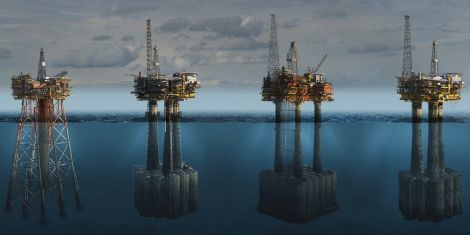News / Shell aims to leave concrete legs in North Sea
SHELL has drawn a mixed response from environmental groups after stating its intention to leave the huge steel-and-concrete legs of its Brent oil platforms in the North Sea when it completes decommissioning.
A company spokesman last week confirmed plans to seek an exemption from the UK government allowing the legs, which each weigh around 300,000 tonnes, to be left in the sea on safety grounds.
The Brent fields are just over 100 miles to the north-east of Shetland.
Environmental groups including WWF have expressed concern, along with Scottish Green MSP Mark Ruskell – party spokesman for climate, energy and the environment.
Ruskell said Shell and its shareholders had made millions from North Sea oil and gas. It now “has a duty to give something back” and has “the money, the manpower and the ingenuity” to find a safe way to remove the structures.
“Just because these steel and concrete structures are difficult and expensive to deconstruct and move doesn’t mean Shell should walk away from its responsibilities.
“Unless there is an overwhelming environmental case for retaining some structures on the seabed then they should be removed in their entirety.”
Locally, marine pollution organisation KIMO’s secretariat Arabelle Bentley said there may be “exceptional circumstances” where leaving installations at sea was the least harmful option.
“KIMO has always supported the onshore decommissioning of disused offshore installations on the principle of protection of the environment,” she said.
“Whilst we affirm that reuse, recycling or final disposal on land should be the default position, we recognise that there may be exceptional circumstances under which comparative assessment indicates that the potential harm to the marine environment will be greater if some parts of an installation are removed than if they are left in place.
“Provided that the responsible parties have made adequate provision for implementation of robust, ongoing monitoring and assessment of installations left in situ, and for establishing and satisfying legal liabilities, in exceptional circumstances decommissioning at sea may be an environmentally-sound option.”
Become a member of Shetland News
She added KIMO would await Shell’s final decommissioning plan – to be submitted to the UK department for energy and climate change – and would make a further response if appropriate.
A Shell spokesman said: “Following extensive consultation with a wide range of stakeholders, Shell intends to submit a comprehensive decommissioning plan for the Brent oil and gas field to DECC before the end of 2016.
“As part of this plan, Shell will recommend that the gravity base structures of three of the Brent platforms should be left in place.
“Work is continuing to prepare the Brent Delta platform ahead of its topsides being removed in a single lift operation, which is expected to take place in 2017.”
Become a member of Shetland News
Shetland News is asking its many readers to consider paying for membership to get additional features and services: -
- Remove non-local ads;
- Bookmark posts to read later;
- Exclusive curated weekly newsletter;
- Hide membership messages;
- Comments open for discussion.
If you appreciate what we do and feel strongly about impartial local journalism, then please become a member of Shetland News by either making a single payment, or setting up a monthly, quarterly or yearly subscription.




























































